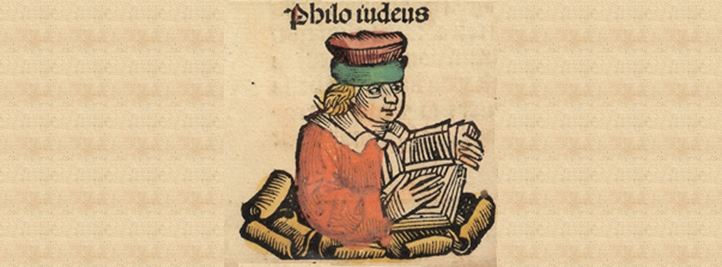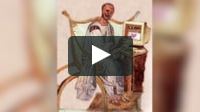Dieser Artikel erscheint im Augustinus-Lexikon in dessen 4. Band, Faszikel 5/6 (2016) auf den Spalten 716-719.
The Jewish-Alexandrian exegete and philosopher P. is mentioned only once in A.’s œuvre, at c. Faust. 12,39 [1]. A. speaks of «Philo quidam, uir liberaliter eruditissimus unus illorum, cuius eloquium Graeci Platoni aequare non dubitant», information derived from Hier., uir. ill. 11 (who praises both P.’s ‹sensus› and ‹eloquium›). P. is named as a Jew who cannot defend Old Testament scripture from misleading and unworthy interpretation because he does not recognize the prophetic references to Christ and his church. The example given is his allegorical interpretation of Noah’s ark in terms of the human body [2] (↗Noe). The source of the example is without doubt P.’s exegesis of Gn 6,14-16 in Quaest. in Gn. 2,1-7. Altaner argued that A. had derived this material via a Latin translation [3] of the work [4]. Against this view Courcelle argued that it had been derived from ↗Ambrosius’ De Noe [5]. Paramelle, who discovered the original Greek text, sided with Altaner, pointing out that A. could not have deduced from Ambrose’s text that he was so indebted to P. [6].
It is certain, therefore, that A. had at least a limited direct acquaintance with P.’s writings. There is no proof, however, that A. ever read any treatise in the original Greek, although it has been suggested for Op. [7]. But there are many echoes of Philonic thought and exegesis in A., the majority were transmitted via the Patristic tradition. P. and the Alexandrian tradition are the source for some of A.’s more Platonizing themes and exegeses.
In at least four areas of A.’s thought the influence of P. is perceptible:
(1) Protology: There are links between P.’s and A.’s exegesis of the Gn creation account, notably the Platonizing interpretation of ‹caelum› in Gn 1,1 as ↗‹caelum caeli› [8], the theory of ‹creatio simultanea› and of the double creation of the cosmos and the human being [9] (↗Creatio, creator, creatura), and of various details of the paradise account [10] (↗Paradisus).
(2) Further exegesis of Gn.: P.’s allegorical and literal interpretations of the early history of humanity and of the Patriarchs (↗Patriarchae) are the ultimate source of many details of A.’s readings, most often mediated via Ambrose and before him ↗Origenes (↗Allegoria, ↗Figura(e)). It has been shown that A. is indebt to P. for his interpretation of Abraham and Sarah in Gn 18 in terms of Stoicizing doctrine of preliminary affections [11]
(3) The heavenly and earthly cities: In the scholarly debates on the origin of the distinction between the city of man and the city of God (↗Ciuitas dei) which underlies A.’s argument in ciu. P.’s name is often mentioned [12]. Martín rightly argues that the question must not only be approached from the philosophical but also from the exegetical point of view [13]. The conceptual pairs that A. establishes between heaven-earth, God-man, Abel-Seth-Cain, Sarah-Hagar, Israel-Ishmael, grace-nature, life-death, love of God-love of self, have their origin in the schemata of P.’s allegorical commentary on Gn [14]. For P. these antitheses are applied to the history of the soul, in A. they are played out in history (↗Dispensatio, ↗Historia).
(4) Theology: P. (followed by Basil) and A. are the only scriptural interpreters who with reference to Ex 3,14sq. make a distinction between the God of Being and the God of the Patriarchs, the former representing God’s unchangeability, the latter God’s mercy towards humanity [15] (↗Ego sum qui sum). It is not possible to determine how A. could have read the relevant Philonic texts. An intermediary role may have been played by ↗Basilius.
Notes
[1] Cf. ALTANER 184; for a more extended treatment of the influence of P. on A. cf. RUNIA, Philo 320-332.
[2] Cf. GROTE 85-91.
[3] Now such a translation survives only for book 4; cf. PETIT.
[4] Cf. ALTANER 191sq.
[5] Cf. COURCELLE, especially 80-83.
[6] Cf. PARAMELLE 75-77; BARTELINK 13.
[7] Cf. SOLIGNAC 1372.
[8] Cf. PÉPIN.
[9] Cf. MAZZANTI.
[10] Cf. AGAËSSE/SOLIGNAC 657-665; ZELLER 116sq.; DULAEY 286.
[11] Cf. BYERS 142-150.
[12] Cf. DUCHROW 80-92; VAN OORT 235-254.274-351.
[13] Cf. MARTÍN 283-285 against VAN OORT 250-254.
[14] Cf. LANDMAN; ELGERSMA HELLEMAN.
[15] Cf. e.g. RUNIA, Platonism 2.
Bibliography
P. AGAËSSE/A. SOLIGNAC, Le double moment de la création et les «raisons causales»: BA 48 (1972) 653-668. – B. ALTANER, Augustinus und Philo von Alexandrien: Kleine patristische Schriften, Berlin 1967, 181-193 (ZKTh 65 (1941) 81-90). – G.J. BARTELINK, Die Beeinflussung Augustins durch die griechischen Patres: Augustiniana Traiectina, Paris 1987, 9-24. – S.C. BYERS, Perception, Sensibility, and Moral Motivation in Augustine: A Stoic-Platonic Synthesis, Cambridge et al. 2013. – P. COURCELLE, Saint Augustin a-t-il lu Philon d’Alexandrie?: REA 63 (1961) 78-85. – U. DUCHROW, Christenheit und Weltverantwortung. Traditionsgeschichte und systematische Struktur der Zweireichelehre, Stuttgart 1970. – M. DULAEY, L’apprentissage de l’exégese biblique par Augustin. Première partie: Dans les années 386-389: REAug 48 (2002) 267-295. – W. ELGERSMA HELLEMAN, Augustine and Philo of Alexandria’s ‹Sara› as a Wisdom Figure (De civitate Dei XV 2f.; XVI 25-32): StPatr 70 (2013) 105-115. – A.E.J. GROTE, «In arca quaedam ad Christum, quaedam ad ecclesiam referuntur» (c. Faust. 12,39). Zur Rezeption von Augustins Arche-Exegese bei Hugo von St. Viktor (1097-1141), Petrus Johannis Olivi (1247/48-1296/98) und Aegidius Romanus (1245–1316): Augustinus – ein Lehrer des Abendlandes. Spuren und Spiegelungen seines Denkens von der Frühscholastik bis in die Gegenwart 1. Von den Anfängen bis zur Reformation (hrsg. von N. FISCHER), Hamburg 2009, 85-104. – C. LANDMAN, The Etymological and Allegorical Functioning of Cain, Abel and Seth in the Exegetical Methods of Philo and Augustine: EkklPh 65 (1983) 17-26. – J.P MARTÍN, Philo and Augustine, De civitate Dei XIV 28 and XV. Some Preliminary Observations: Heirs of the Septuagint: Philo, Hellenistic Judaism and early Christianity. Festschrift for E. Hilgert, Atlanta, Ga. 1991, 283-294. – A.M. MAZZANTI, L’aggettivo μεθόριος e la doppia creazione dell’uomo in Filone di Alessandria: La ‹doppia creazione› dell’uomo negli Alessandrini, nei Cappadoci e nella gnosi (a cura di U. BIANCHI), Roma 1978, 25-42. – J. VAN OORT, Jerusalem and Babylon: A Study into Augustine’s City of God and the Sources of his Doctrine of the Two Cities, Leiden 1991. – J. OTTO, Conflicting Reactions to Philo’s Ark Door Exegesis: Theoforum 42 (2011) 89-98. – J. PARAMELLE, Philon d’Alexandrie: Questions sur la Genèse II 1-7: texte grec; version arménienne, parallèles latins, Geneva 1984. – J. PÉPIN, Recherches sur les sens et les origines de l’expression caelum caeli dans le livre XII des Confessions de s. Augustin: «Ex Platonicorum persona». Etudes sur les lectures philosophiques de Saint Augustin, Amsterdam 1977, 41-130 (ALMA 23 (1953) 185-274). – F. PETIT, L’ancienne version latine des Questions sur la Genèse de Philon d’Alexandrie 1-2 (TU 113.114), Berlin 1973. – D.T. RUNIA, Philo in Early Christian Literature. A Survey, Assen/Minneapolis, Minn. 1993. – Id., Platonism, Philonism, and the Beginnings of Christian Thought: Philo and Church Fathers. A Collection of Papers, Leiden/New York/Köln 1995, 1-24. – Id., Philon von Alexandria: RAC Lfg. 213 (2015) 605-627. – A. SOLIGNAC, Philon d’Alexandrie II. Influence sur les Pères de l’Eglise: DSp 12 (1984) 1366-1374. – D. ZELLER, Philo’s spiritualisierende Eschatologie und ihre Nachwirkung bei den Kirchenvätern: Studien zu Philo und Paulus, Göttingen 2011, 101-118 (Vom Jenseits. Jüdisches Denken in der europäischen Geistesgeschichte (hrsg. von E. GOODMAN-THAU), Berlin 1997, 19-35).
DAVID T. RUNIA
Professor für antike und patristische Philosophie,
University of Melbourne
© (Text) Verlag Schwabe AG, Basel
Wir danken dem Schwabe Verlag für die freundliche Genehmigung zur Veröffentlichung in unserem Webportal.



